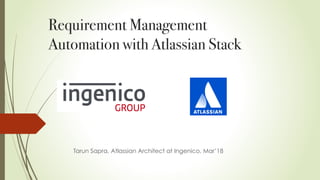[Jira Day 2018] Requirements Management Automation with Atlassian Stack
- 1. Requirement Management Automation with Atlassian Stack Tarun Sapra, Atlassian Architect at Ingenico, MarŌĆÖ18
- 2. Why tools ? Why automate ? ! Requirements located in a centralized location and easily accessible via a set of decentralized well connected Atlassian Apps. ! Leveraging the tools to give structure to the requirements. ! Achieving Traceability by linking requirements to development items, test cases and release plans. ! Advance dashboards which act as information radiators for everyone involved in the product development lifecycle. ! Globally distributed Scrum teams canŌĆÖt function without the right tools. ! Atlassian marketplace has thousands of plugins to support the automation process and plug in the gaps in the default functionality. ! Use of permission schemes helps in implementing ubiquitous security mechanism across various systems.
- 3. Spotify Agile Model Scaling Agile @ Spotify - Henrik Kniberg & Anders Ivarsson
- 4. Giving structure to requirements Portfolio Tribe Squad
- 5. Delivery rhythms Strategy ŌĆó Product stream / High level roadmap Release ŌĆó Release Plan/High-Level Estimates Sprint ŌĆó Sprint Plan/ Estimation/ Story points CI/CD ŌĆó Integration/Release/Builds Initiative Epics/Features Stories
- 6. Mapping requirements - recommended structure in JIRA & Confluence One Tribe One JIRA Project One Squad One Scrum Board A Release Roadmap Set of Epics over time A Product Stream / Business Roadmap Set of Initiatives over time A Release Version FixVersion Sprint backlog Sprint backlog Stories Requirements tasks hierarchy Portfolio/JIRA Requirements content hierarchy Confluence
- 7. Reporting EssentialsŌĆ© Keep it lean: make reporting a dashboard, not an activity! ŌĆ© ! Effective dashboards giving an insight to tribe leads about the progress of issues across the full production chain. ! Display the historical velocity of all sprints instead of the just one sprint and the velocity achieved per release cycle. ! Shows evolution of product backlog over a period of time. ! Indicates the features to be released in upcoming release cycle. ! ŌĆ” and the ones released in latest release cycle. ! Show the number and the list of defects created and resolved per release cycle. ! Tracks progress of Initiatives across tribes and squads at story level using the ratio of story points completed. ! Tracking progress of epics at tribe level by grouping stories across the epics (applicable for a specific set of epics, typically for a specific customer project) ! Issues removed (de-scoped) from release cycle.
- 8. Plugin essentials ! Arsenale dataplane / eazyBI ŌĆō Reporting plugin for creating reports and embedding the reports onto dashboards using gadgets. ! Script Runner ŌĆō Automation of various business processes & enforcing certain project governance regulations for consistency in workflow and reporting across tribes ! Tempo Timesheets ŌĆō Extracting reports about worklogs ! JIRA Portfolio ŌĆō Portfolio level view of things across tribes and squads ! Better excel reporting ŌĆō extracting reports in excel using custom templates ! Gliffy ŌĆō Creating Architecture/Business flow diagrams in confluence ! Comala workflows ŌĆō Approvals and Reviews for created content.
- 9. Confluence and JIRA essentials ! Requirements hierarchy split across JIRA IssueTypes ŌĆō Story, Epic and Initiative ! Each type having itŌĆÖs workflow and thus definition of done varies across types based on the business requirements. ! Leveraging combination of Scrum & Kanban boards for the feature lifecycle. ! Creating advance dashboards using filters and plugins and sharing with the management. ! Setting up the content hierarchy structure in Confluence. ! Displaying JIRA tickets and charts in Confluence using JIRA macros and charts macros. ! Creation on sprint and release notes in confluence and linking it back to JIRA.
- 10. DEMO TIME!










